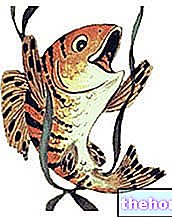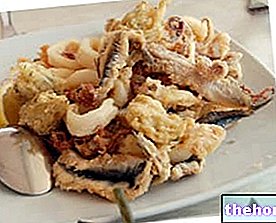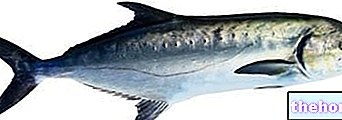What are Sardines
Sardines (or sardines) are animals that fall into the group of fish.

In human nutrition, sardines are part of the whole of fishery products and, being part of the first fundamental group of foods, they contain above all: proteins with a high biological value, some vitamins and mineral salts typical of this category.
Despite their nutritional richness, sardines are considered "poor fish" and the most famous recipes are: Fried Sardines, Sarde Scotta Dito ai Ferri, Sarde in Saor, Stuffed Sarde alla Ligure and Sarde Beccafico.
Pasta With Salted Sardines
Problems with playing the video? Reload the video from youtube.
- Go to the Video Page
- Go to the Video Recipes Section
- Watch the video on youtube
Nutritional Characteristics
Sardines are foods that do not lend themselves to vegetarian, vegan and Hindu diets; instead they are granted in the kosher and Muslim diets.

Nutritional values (per 100 g of edible portion)
Sardines have an average energy intake and are not part of the category of lean fish; on the other hand, avoiding the use of oil to dress them, it is possible to take them in the same quantities (for example) as sea bass and sea bream. This clarification is not accidental and aims to sensitize readers towards a greater consumption of sardines in the diet. In fact, from a qualitative point of view, in addition to representing a considerable economic saving, eating sardines instead of any other farmed white fish significantly increases the intake of certain nutrients (including especially omega 3).
The calories of sardines come essentially from proteins, followed by lipids and very few simple carbohydrates. They have a medium cholesterol concentration and do not contain fiber. The peptides are of high biological value and the predominantly polyunsaturated fatty acids (with great importance of the essential polyunsaturated omega 3).
The main vitamins in sardines are: niacin (vit PP), vit A (retinol) and, even if not shown in the table, vitamin D or calciferol.
As for the mineral salts, potassium, iron, phosphorus and iodine abound (details not present in the table).
Sardines are suitable for any type of diet even if, like most foods, the relative portion should be adapted to any condition of overweight.
The good concentration of essential fatty acids of the omega 3 group favors the normalization of lipemia (especially cholesterol and triglyceridemia), tends to improve primary arterial hypertension and prevents some complications related to type 2 diabetes mellitus.
It should be specified that, due to the likely presence of anisakis (parasite), sardines cannot be eaten raw unless the temperature is reduced. After cooking, these organisms are totally eliminated but, to keep the omega 3 levels intact, frying should be avoided.
The average portion of sardines is 200-250g (260-320kcal).
Description and Biology
Sardines are defined as bony fish (osteichthyes) because, unlike chondrichthyes (cartilaginous fish such as sharks), they have a skeleton made up of hydroxyapatite (calcium, phosphorus and collagen).
They have a sub-cylindrical shape characterized by a more rounded belly as they increase in size of the specimen. The back is bluish or greenish, the sides are characterized by some black spots and the belly seems almost white; the whole livery is typical of a large brilliance. The scales are large and the mouth very wide. It reaches a maximum length of 27-30cm.
Sardines are typical organisms of the Mediterranean Sea, the Black Sea and the North-Central Atlantic Ocean (limited to the European and African continents). They have seasonal pelagic habits; they usually live between 25-55 meters deep during the hours of light. and rise up to 10-35 meters at night. In the Mediterranean, they approach the coast only in summer, while in winter they also reach bathymetric depths that exceed 100m.
Sardines feed on phytoplankton (in the larval state) and zooplankton or other small organisms; on the other hand, they are eaten by a huge variety of predators: other fish (tuna, sharks, rays, skipjack, mahi mahi, greenhouse, amberjack, lecce, garfish, mackerel, lanzardi, alletterati, etc.), marine mammals (dolphins, humpback whales etc.) and birds (seagulls, cormorants, etc.).
Sardines are the object of a rather intense fishing and, despite their ability to lay up to 80,000 eggs per specimen, they are progressively decreasing in population. What's worse is that, in addition to being fished with great intensity, they are often disposed of without even reaching the fish counters due to their unsustainable selling price for professionals.
Fish, Molluscs, Crustaceans Anchovies or Anchovies Garfish Alaccia Eel Lobster Herring Lobster Whitebait Bottarga Sea bass (Sea bass) Squid Canocchie Scallops Canestrelli (Sea scallops) Capitone Caviar Mullet Monkfish (Monkfish) Mussels Crustaceans Dates Sea Fruits Fish Flour Fauna Fish stock Prawns Crabs Spider crab (Granceola) Halibut Sea salad Lanzardo Leccia Sea snails Prawns Cod Molluscs Octopus Hake Ombrina Oysters Sea bream Bonito Pangasius Paranza Anchovy paste Fresh seasonal fish Blue fish Puffer fish Swordfish Plaice Octopus (Octopus) Hedgehog of Sea Amberjack Salmon Sardines Sardines Scampi Cuttlefish Mackerel Sole Stockfish Surimi Sushi Telline Tuna Canned tuna Mullet Trout Fish roe Bluefish Clams OTHER FISH ARTICLES Categories Alcoholic Food Meat Cereals and derivatives Sweeteners Sweets Offal Fruit Dried fruit Milk and derivatives Legumes Oils and fats Fish andpeach products Salami Spices Vegetables Health recipes Appetizers Bread, Pizza and Brioche First courses Second courses Vegetables and Salads Sweets and Desserts Ice creams and sorbets Syrups, liqueurs and grappa Basic preparations ---- In the kitchen with leftovers Carnival recipes Christmas Light diet recipes Women's, mom's and dad's day recipes Functional recipes International recipes Easter recipes Celiac recipes Diabetic recipes Holiday recipes Valentine's Day recipes Vegetarian recipes Protein recipes Regional recipes Vegan recipes




























